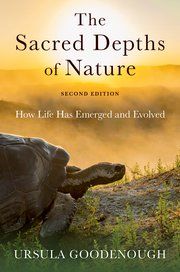Environment
The Sacred Depths of Nature
Biologist Ursula Goodenough explores evolution, emotions, religion, and death.
Posted February 15, 2023 Reviewed by Gary Drevitch
Key points
- "Religious naturalism" argues that all that exists and occurs is due to natural processes and all life exists in interconnected ecosystems.
- A biologist discusses the workings of life and offers spiritual reflections on the complexity of nature and reverent wonder.

The first edition of eminent biologist Ursula Goodenough's The Sacred Depths of Nature remains one of my favorite heavily marked-up books, and the second edition, highly revised and expanded, is another gem. All in all, it is a fascinating, wide-ranging, beautifully written, and eye-opening book that considers the origins of the earth, the origins of life itself, where we are now, where we are most likely heading, and the importance of developing a shared global cosmology and ecomorality that can benefit us all in the future.
I'm glad Goodenough answered a few questions about her landmark book.
Marc Bekoff: Why did you originally write and then update The Sacred Depths of Nature?
Ursula Goodenough: In the 1990’s I developed connections with persons like Thomas Berry, Brian Swimme, and Loyal Rue who were exploring the religious potential of our scientific understandings of nature, and I jumped on board to write a book about my own perspective, calling it a religious naturalist orientation. After 25 years, some of the science needed updating, but I also sought to articulate the perspectives I had gained from reading/hearing and incorporating many new voices. So I’d say that well over half of the second edition is new writing.
MB: How does your book relate to your background and general areas of interest?
UG: In the lab, I studied single-celled organisms at the molecular level, so while the book for sure considers nature writ large, there’s a focus on this level of biological organization. I’ve nurtured a gift for explaining the very small to the uninitiated; one reviewer writes, “Finally, someone who can breathe life into molecules and make us feel it.”
MB: Who is your intended audience?
UG: I hope that each reader is curious about how the world works and came to be, and is interested in exploring how such understandings can deepen and enrich her/his spiritual and moral dimensions. I assume that my reader needs guidance and do my best to give it. That said, many readers of the first edition were “science literate” but found themselves engaged by the analogies and storylines used to explain the familiar.
MB: What are some of the topics you weave into your book and what are some of your major messages?
UG: Humans are narrative beings—we think and feel in stories—and the cultures that we have created and inhabited throughout our history are invariably anchored in large stories—Myths—as to how things are and which things matter. Scientific inquiry has provisioned us with a new large story, one we call Everybody’s Story, that tells of 13.8 billion years of cosmic, planetary, biological, and cultural evolution. A naturalist takes this story to mind; a religious naturalist takes this story to mind and to heart.
A religious quest takes three trajectories: the Interpretive (what does this story tell me about the meaning of life?); the spiritual (how does this story make me feel along such interior axes as reverence, awe and wonder, humility, gratitude, assent, and joy?); and the (eco)moral (what does this story tell me about right human-human relations and human-earth relations?).
Each chapter considers a particular facet of the story—the origins of life, how life and organisms and evolution work, awareness and meaning, sex and intimacy, multicellularity and death—and offers in response a spiritual reflection infused with poetry and with wisdoms from the traditional and indigenous traditions. The final chapter focuses on (eco)moral responses, where Everybody’s Story is uniquely suited to frame and guide the conversation. The book gives deep consideration to animal emotions, tracing their deep origins, their homologies, and their manifestations in human animals.

MB: How does your book differ from others that are concerned with some of the same general topics?
UG: A commendable feature of the religious naturalist orientation is that it is open to numerous articulations, the only rule being that you start with a mindful understanding of natural reality. Many books, past and present, are referenced in the book that speak in myriad voices.
MB: Are you hopeful that as people learn more about the origins of life and how the earth and we came to be they will treat our planet and humans and other animals with more respect and decency?
UG: Yes. If I weren’t hopeful, I guess I wouldn’t have written this book!
References
In conversation with Dr. Ursula Goodenough, Professor of Biology Emerita at Washington University who retired to Martha’s Vineyard in 2017. She is a fellow of the American Academy of Arts and Sciences and the American Microbiology Society and served as president of the American Society for Cell Biology. She and many others are developing what is called a religious naturalist orientation and a new edition of her book, The Sacred Depths of Nature: How Life Emerged and Evolved, describes her understandings of this orientation.


